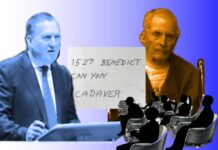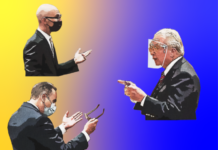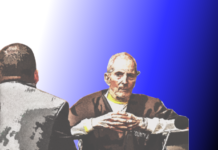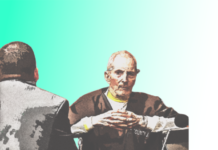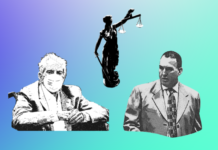You can find part three of this story here. Links to all of CRIME STORY’S coverage of the Robert Durst trial are here.
On the last night of her life, Dec. 22, 2000, Susan Berman picked up her friend Richard Markey, and drove her Isuzu —an SUV rebuilt by her mechanic to replace the LeBaron — to dinner at the Broadway Deli in Santa Monica. Then, they took in a movie, “Best in Show.” She dropped him off afterward, at about 10:30 pm, Markey said, “and that was the last time I saw her.”
At home in Benedict Canyon, Berman, 55, changed into purple sweatpants and a white t-shirt. At some time during the ensuing hours, her killer — most likely someone she knew because she never opened her door to strangers, or even to friends who hadn’t called ahead — showed up at Susan’s house. The killer followed her inside, put a 9mm pistol close to the back of her head, and pulled the trigger. Berman was dead by the time she hit the floor.
It wasn’t until after neighbors saw that Susan’s terriers were running free — a life threatening event on Benedict Canyon Boulevard where cars often came whipping down the narrow street — that they called police. Berman’s back door was open; the front door unlocked.
Patrol officers found Berman lying flat on her back on the floor of a bedroom, her head and hair resting in a pool of blood. There was no forced entry. Her purse was on the kitchen table, containing credit cards and a small amount of cash.
Suspicion initially fell on Susan’s landlady — whom Berman told friends, had once threatened her with a gun over back rent — and Berman’s manager, Nyle Brenner, who had climbed in a window of the bungalow, which had apparently not been sealed off after the police left. Eventually, they were both cleared and detectives focused on Mr. Durst.
In the days after her death, many of Susan’s friends and family members recoiled at the idea that Durst killed Berman, saying “Bobby loved Susy; Susy loved Bobby.” “I don’t believe that anything that happened to Susy, has to do with Robert Durst,” Berman’s cousin Deni Marcus told me.
The murder of Susan Berman was not the first bit of star-crossed mayhem in Benedict Canyon. About 12 houses down from Susan’s bungalow, actor George Reeves, best known as Superman, was found dead of a gunshot wound on June 16, 1959. Police ruled his death a suicide, but Reeve’s mother, actor Alan Ladd and others suspected murder, possibly by the mob. And less than half a mile from Susan’s bungalow, the Manson family murdered Sharon Tate and four others at 10050 Cielo Drive on Aug. 9, 1969.
A close friend of Berman’s since childhood, Susie Harmon told the San Francisco Chronicle after her death, “Susan could get a wall to talk. That’s the irony We keep saying we need Susan here to solve this.”
With Berman’s memorial set for Feb. 1, 2001 in Beverly Hills, Durst arrived in California, booking a room at the Hotel Shangri La in Santa Monica. He planned to attend the service, but his lawyers prevailed on him to avoid the event, which was bound to attract reporters. “Bobby was there in Santa Monica,” said Kim Lankford, who briefly dated Durst. “He said he didn’t come because when you’re paying millions for legal advice, you pay attention to it. I thought it was a bad choice if he was indeed innocent.”
LAPD eventually cleared Berman’s landlady, after determining that the dusty gun the woman owned was not the murder weapon. Her manager was also ruled out as the killer.
Over the ensuing weeks, Durst went on what one of Berman’s friends called a “good will tour,” commiserating with Berman’s friend over her death. He met with Kim Lankford and Markey at Guelaguetza, a Mexican restaurant in Los Angeles and with Johnson in New York. He told Johnson that he had been “touched and moved” by Berman’s last letter, thanking him for the money he sent.
Detectives, meanwhile, were trying to figure out who wrote an anonymous note, alerting police to the location of a “cadaver” at Berman’s bungalow. It was postmarked on the same day Berman was killed. Durst vehemently denied that he killed her, insisting he was not even in Los Angeles at the time, nor had he written what became known as the “cadaver” note.
Over the next three years, the LAPD investigation seemed to stall, eventually becoming a cold case.
Durst, in turn, had his own problems. Ten months after Berman’s death, Durst was arrested for the murder and dismemberment of the man who lived across the hall from him in Galveston, Morris Black. The two men had become friendly and Black had eventually learned of Durst’s true identity. Durst would later tell a jury that Black, a cantankerous man, had grabbed Durst’s handgun from the oven in his apartment. They struggled over the gun, he said, and as they fell to the ground, the gun went off, killing Black.
Durst testified that he had sat in a pool of blood as he carved up Black’s body and then dropped the parts in Galveston Bay, thinking that no one would believe his claim of self-defense. In the end, the jury believed his story and acquitted him at trial in 2003.
The cold case files for both Berman’s death and Kathie Durst’s disappearance would have continued gathering dust if Durst had not decided in 2010 to start talking, and talking, and talking. After 10 years of trying, I got my first interview with him. More importantly, he agreed to what became more than 20 hours of interviews with filmmakers Andrew Jarecki and Marc Smerling. He gave them unfettered access to his private papers, legal files, family photos and credit card and phone bills. Those encounters resulted in the six-part HBO documentary, “The Jinx: The Life and Deaths of Robert Durst.”
I talked to Durst briefly after each episode aired, trying to gauge his reaction. After the fifth episode, Durst seemed to know that he had gotten himself into trouble and rushed me off the phone. A few days later, a friend of Durst’s told me he was hiding at the J.W. Marriott hotel in New Orleans, under an alias. I thought, “He’s going to run.” The next day Durst was arrested on a murder warrant.
Even before the film’s 2015 broadcast, the filmmakers, who had turned up a piece of new evidence, brought their work to Lewin in Los Angeles. Lewin, who specializes in cold cases, especially murders without a body, and the LAPD reopened the case and ultimately arrested him in New Orleans, hours before the airing of the final episode of the Jinx.
Durst’s $10 million defense team spent the next five years arguing Durst did not write the so-called cadaver note. They also unsuccessfully opposed the prosecution’s use of handwriting analysts to tie Durst to the note.
In his opening statement on March 9, Lewin said that Durst “waited for Susan to turn her back on her best friend, someone she loved and trusted, and he executed her at point blank range.” He contends that the murder of Berman, and the death of Black, are tied to the 1982 disappearance and murder of Kathie Durst. Durst killed Berman, he said, to prevent her from telling investigators what she knew about Kathie Durst’s death. She had a dual role, as Durst’s accomplice in 1982, and as Durst’s victim 18 years later.
On the 19th anniversary of Berman’s killing, shortly before the trial started, Durst’s lawyers suddenly conceded for the first time that Durst was in Los Angeles at the time of her death. And after two decades of emphatically denying that he had anything to do with the “cadaver” note, his lawyers also stipulated that Durst was in fact its author. Durst’s new account of his actions jibed with a story I had heard five years earlier from a member of Durst’s small circle of friends. It seemed so improbable.
Dick DeGuerin, who leads Durst’s legal team just as he had in Galveston, said in his opening statement weeks later, that Durst “did not kill Susan Berman and does not know who did.” Yes, he said, Durst had told Berman that he was coming to visit her during the Christmas holidays, as he had done in previous years. DeGuerin said Durst used his own key to get into Berman’s bungalow. “Bob showed up and found her dead and he panicked. He wrote the anonymous letter so her body would be found, and he ran. He’s run away his whole life.”
In a follow-up to DeGuerin, defense lawyer David Chesnoff emphasized that there were no fingerprints, fibers, DNA or other evidence linking Durst to Berman’s death. “No evidence is evidence,” Chesnoff told the jury.
While there is no direct evidence tying Durst to the shooting, there is plenty of other evidence. Besides their concession that Durst was at the crime scene before Berman’s body was discovered by the police, and that he wrote the “cadaver note,” the defense lawyers have not explained why Durst drove an oddly circuitous route to Los Angeles — flying to San Francisco and then up to Eureka, CA, picking up his Ford Explorer near a home he kept in Trinidad, CA; driving south to LA on December 20; showing up at Berman’s home at some time either late on December 22 or early on the 23rd; and dropping the “cadaver note” in a Marina del Rey mailbox at some time on December 23 — before flying out of San Francisco on Christmas Eve. It was a grueling 1,000-mile journey taken over just a few days.
When the trial resumes, the defense will also have to contend with testimony from Nick Chavin, a longtime defender of Durst and a close friend of both Durst and Berman. The first time I interviewed him in November 2000 he urged me to speak to her. He told me that Berman had told him that Bob “did it,” a statement that shocked me. But in the next breath, he said he didn’t believe her. She was a storyteller, he said, and Bob was not capable of violence.
But years after Berman’s killing and Durst’s acquittal in Texas, Chavin was forced to choose between his loyalty to Durst and his loyalty to Berman. Durst had contacted him in late 2014, offering a renewed friendship and a key to his townhouse in Harlem. Chavin told me at the time that Durst had invited him to dinner that December, where he wanted to talk about “Susy and Kathie.” The prosecution subsequently featured Chavin at a pre-trial hearing as a “mystery witness.”
But before Chavin took the stand, Durst’s defense team asked Judge Mark Windham to sequester me so that I could not hear his testimony. Lawyer David Chesnoff argued that I had “spent a career investigating Durst and circumstances surrounding Mr. Durst’s entanglements.” The defense hoped that I would impeach Chavin’s testimony by referring to my interviews with him 17 years earlier.
A New York Times lawyer argued that the defense motion was a violation of the first amendment and would penalize a reporter for doing a good job. Judge Winham quickly dismissed the defense motion and Chavin took the stand.
Chavin testified that he and Durst had dinner at Barawine, a bistro near Durst’s townhouse. As the two men were leaving the restaurant, Chavin asked Durst what he wanted to say about Berman. Durst was quiet for a moment, Chavin said, before three sentences rumbled from his mouth: “I had to. It was her or me. I had no choice.”
A full 20 years after her execution style murder, Susan Berman’s final and most tragic story remains incomplete.
Charlie Bagli has been covering the Robert Durst mystery for two decades, mostly for The New York Times, but also for Los Angeles Magazine and Town & Country magazine.


